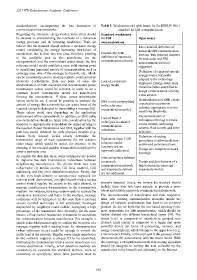Page 184 - Proceedings of the 2017 ITU Kaleidoscope
P. 184
2017 ITU Kaleidoscope Academic Conference
standardization, encompassing the true dimension of Table 3. Weaknesses and open issues for the IEEE P1906.1
communication nanonetworks. standard for EM communications
Regarding the reference energy model, more effort should Standard weaknesses
be devoted to characterizing the functions of a nanoscale for EM Open issues
energy generator and its operating conditions. Thus, we communications
believe that the standard should include a reference energy More detailed definition of
model, considering the energy harvesting restrictions of nanoscale EM communication
nanodevices due to their tiny size (and, therefore, pointing Excessively open devices. Two separate chapters
to the available area in the nanodevice for the definition of nanoscale for molecular and EM
nanogenerator) and the environment under study. So, this communication network. nanocommunication are
reference model would establish a more solid starting point suggested.
to quantifying important aspects of communication, such as Definition of a general enough
coverage area, size of the message to transmit, etc., which
can be consistently used to develop realistic communication energy model, but easily
adapted to the technology
protocols. Furthermore, from our point of view, the Lack of a reference employed. Energy restrictions
standardization of both maximum and recommended power energy model. should be better quantified to
transmission values would be relevant, in order to set a
common power consumption model for nanodevices design a nanonetwork offering
a real service.
forming the nanonetwork. If these power transmission
values could be set, it would be possible to estimate the SNR is not contemplated Standardization of SNR values
amount of energy that a nanodevice can waste (most of the in the reference expected at reception to
required energy is dedicated to transmitting a message [6]). communication model. calculate appropriate receiver
These values could vary depending on the application sensitivity thresholds.
environment of the nanonetwork. In addition, an SNR value Lack of layer 2 Recommendation of
recommendation should be taken into consideration by the techniques to enhance techniques referring to media
standard, to appropriately demodulate the signal arriving to communication access control, addressing
the receiver. Power transmission and SNR, together with the robustness. scheme, flow control and error
path loss model obtained for each physical medium (e.g. detection.
human body tissues) would clearly determine the Definition of routing
transmission range of each nanodevice for the scenario Equivalent layer 3 OSI procedures to allow multi-hop
under study, which would be useful, for instance, in the reference model end-to-end communications.
planning of the required number of nanodevices deployed to functions are not Design of a complete network
cover a particular area. rigorously addressed. topology.
As regards the data link layer, some techniques are needed Interconnections between
to improve the data transmission robustness between a nanoscale Design and development of a
neighboring nanodevices. We divide them into four communication network link between the nano and
subgroups: (i) media access, (ii) flow control, (iii) and macroscale devices macroscale worlds.
addressing, and (iv) error detection/correction. Firstly, due are not addressed.
to the very high density of nanodevices expected for
nanonetwork deployment, straightforward media access
control should regulate the access to the radio channel, to properly detected. Hence, we believe the standard should
manage simultaneous transmissions in the transmission include these data link layer aspects, to provide a more
medium. For instance, by using random seeds to activate the robust and reliable nanoscale communication framework.
nanodevice transceiver and listen to the medium, message The interconnection of nanodevices and their respective
collisions will be mitigated. In the case that a medium links with existing communication networks entails the
access control technique is not employed, messages design of network architectures that have to be properly
dispatched by neighbors could collide, corrupting a high planned. So far, we think that the tree-based topology is the
percentage of the transmitted data. Secondly, for the same most appropriate for EM nanonetworks, which should be
reason, a flow control mechanism is essential to coordinate further divided into different hierarchical layers [19]. The
the communication between nanodevices. For example, a lowest level is composed of nanodevices grouped into
simple acknowledgement reply to confirm the reception of a clusters. Each cluster is connected to a larger and more
message, together with a waiting timer for retransmissions powerful device (in terms of processing, memory, and
(when collisions occur) could be enough to control the energy consumption), which belongs to the upper level (e.g.
traffic load in the network. Thirdly, every single nanodevice a nano-router). Finally, in the top layer is the gateway which
in the network requires a unique ID to be identified, interconnects the nanonetwork with the macro world. With
facilitating the transmissions from a source nanodevice to a this topology, a straightforward multi-hop routing algorithm
remote destination. Finally, error detection methods are should be designed to convey the data collected by the
mandatory to evaluate the standard metrics, such as nanodevices in the lowest level, ultimately, to the Internet.
sensitivity or specificity, since false positives must be
– 168 –

